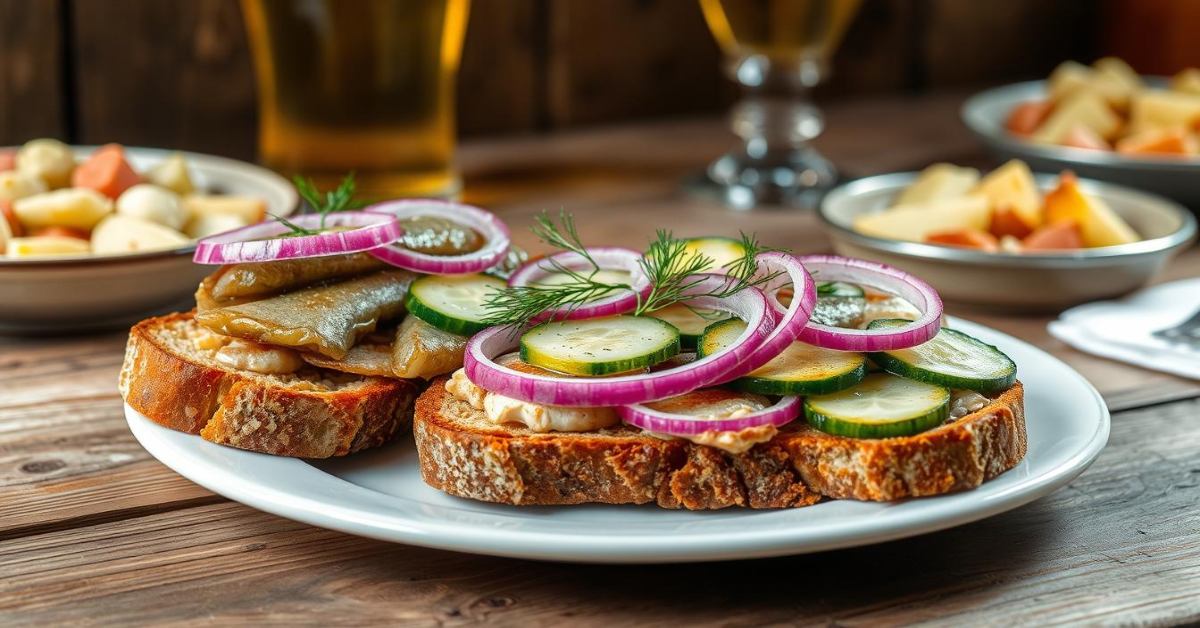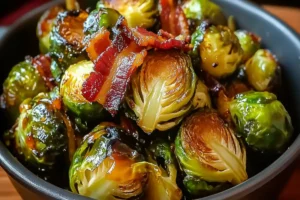While walking through Hamburg's busy streets, I caught the scent of fresh bread and pickled herring, leading me to discover the famous Matjesbrötchen recipe. This German sandwich combines young, pickled herring with crisp, fresh ingredients, creating a local favorite. The first bite was a revelation, offering a perfect balance of flavors and textures that define this beloved Northern German treat.I was hooked and wanted to make it at home. I knew it would bring a taste of coastal Germany to my kitchen. In this guide, I'll teach you how to make a real Matjesbrötchen recipe. It's a classic German fish sandwich that will take you to Northern Germany's seaside towns. With a few ingredients and some prep, you can enjoy this regional specialty at home. Let's start and learn how to make a delicious Matjesbrötchen!
Table of contents
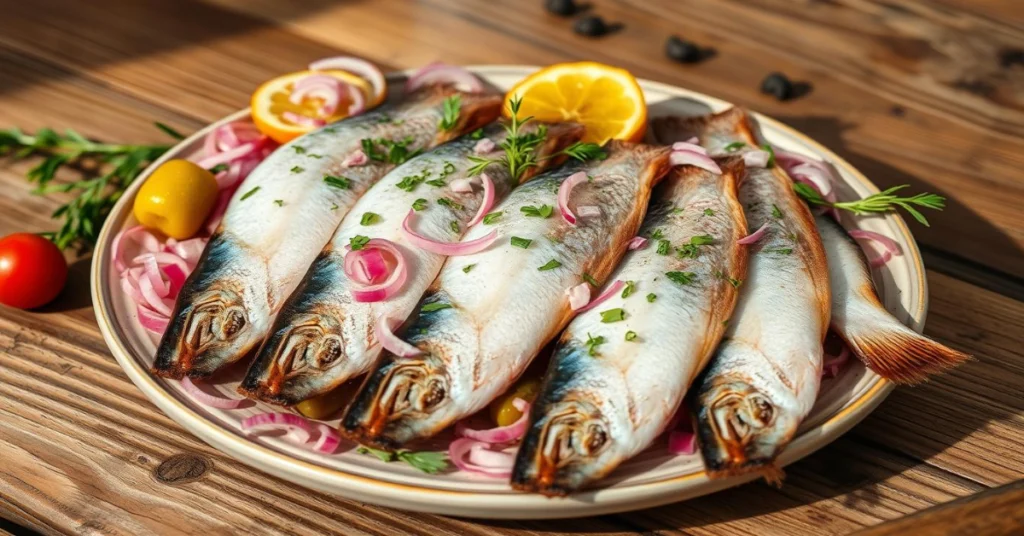
Understanding the Matjesbrötchen Recipe: A Northern German Delicacy
Matjesbrötchen recipe is a traditional Dutch fish sandwich loved in Northern Germany. It started centuries ago in coastal areas. It was a way for locals to enjoy the sea’s bounty easily.
This dish is a symbol of Germany’s rich sea culture. It’s celebrated as a national culinary treasure.
Origins and Cultural Significance
The main ingredient is Matjes herring, a young herring. It’s caught, cleaned, salted, and marinated in vinegar in early summer. This makes the fish mild and tender, perfect for the bread.
What Makes Matjesbrötchen Recipe Special
Matjesbrötchen is more than a quick meal; it’s a cherished part of Northern German food culture. This delicious treat is often enjoyed as a light lunch, snack, or casual dinner. Perfect for seaside picnics, local festivals, or simply as a satisfying bite, it embodies the essence of regional cuisine. Beloved by locals, it holds deep roots in the maritime traditions of the area.
Traditional vs. Modern Variations
While the classic Matjesbrötchen is still loved, chefs and home cooks are trying new things. They’re adding unique sauces and toppings and using different bread. This keeps the dish fresh for today’s tastes while keeping its Northern German roots.
“Matjesbrötchen is not just a meal, but a representation of German culinary culture – a delicious bridge between the land and the sea.”
Essential Ingredients for the Perfect Matjesbrötchen Recipe
To make the classic German dish of Matjesbrötchen, you need a few key ingredients. At the heart of this recipe are the fresh, succulent matjes herring fillets. They give the sandwich a delicate and tangy taste.
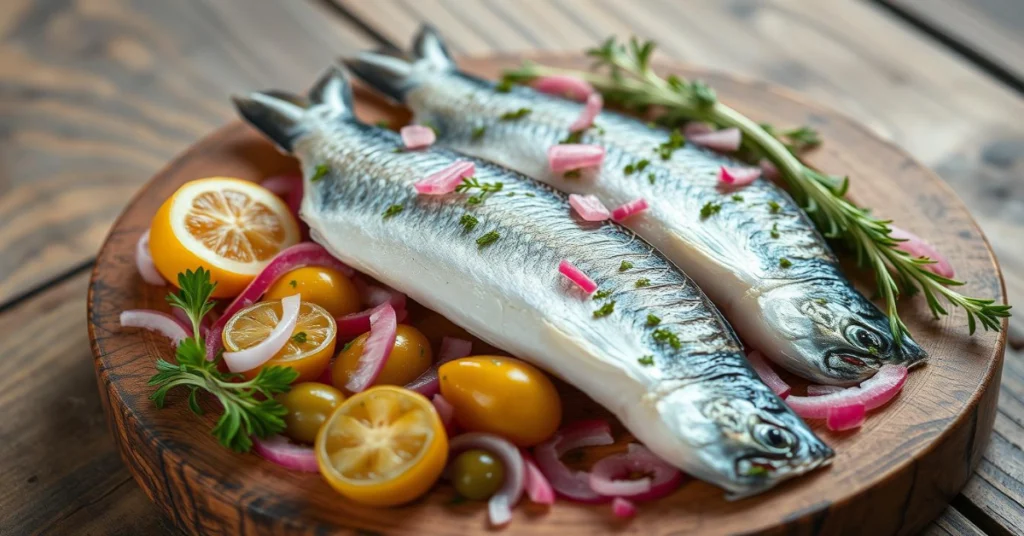
Next, you’ll need crisp, crusty bread rolls for a satisfying crunch. Thinly sliced red onions add a refreshing bite. Dill pickles offer a tangy counterpoint. Fresh herbs like dill or parsley add an aromatic touch.
To enhance the flavor, a light butter or dressing is used. Remoulade or tartar sauce works well. These ingredients come together to create the quintessential Matjesbrötchen experience.
| Ingredient | Quantity |
|---|---|
| Matjes herring fillets | 2-3 fillets |
| Crusty bread rolls | 4 rolls |
| Red onion, thinly sliced | 1 small onion |
| Dill pickles, sliced | 4-6 slices |
| Fresh herbs (optional) | A few sprigs |
| Butter (optional) | 1-2 tbsp |
| Dressing (optional) | 2-3 tbsp |
The quality of the ingredients, especially the matjes herring and the bread rolls, is crucial. They determine the best flavor and texture in the Matjesbrötchen sandwich.
The Art of Selecting Quality Matjes Herring for Your Matjesbrötchen Recipe
Choosing the right pickled herring on bun or matjes herring sandwich starts with quality matjes herring. This fish is essential for a real Matjesbrötchen. To get the best taste and texture, follow these shopping tips.
How to Choose Fresh Herring
Look for herring that’s tender, moist, and shiny. The flesh should be firm, without drying or color changes. Avoid herring that’s too salty or smells strongly of fish, as these are bad signs.
Understanding Matjes Preparation
Matjes herring is marinated gently to get its unique taste. This process keeps the fish sweet and tender. The special way it’s prepared makes it different from other pickled herring.
Storage and Handling Tips
- Always keep matjes herring cold, between 35-40°F (2-4°C).
- Store it in its original packaging or a tight container to keep it moist.
- Use it within 3-5 days for the best taste and freshness.
- Handle it carefully to avoid damaging its delicate flesh.
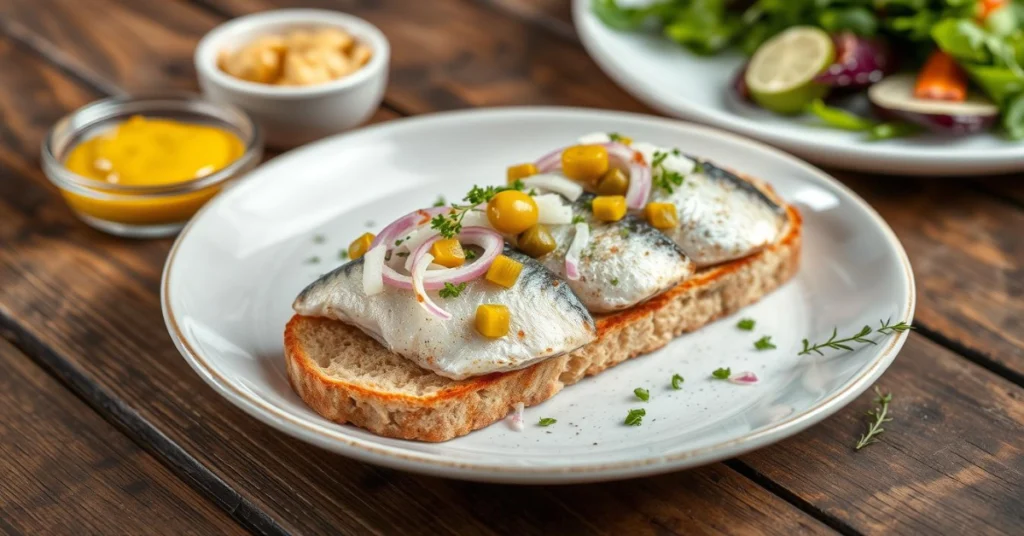
By following these tips, you’ll make a great pickled herring on bun or matjes herring sandwich.
Bread Selection and Preparation Techniques for the Matjesbrötchen Recipe
Choosing the right bread is key for a great crusty bread rolls in your traditional dutch fish sandwich. Go for fresh, crusty bread rolls or Brötchen. They should be soft inside but have a crunchy outside. This ensures the bread can hold the tasty fillings without getting soggy.
Some recipes recommend lightly toasting the bread for extra crunch. This step can make the crusty bread rolls even better. It helps the traditional dutch fish sandwich stay together and offers the perfect mix of textures.
- Choose fresh, crusty bread rolls or Brötchen with a soft interior and slightly crunchy exterior.
- Select bread that is sturdy enough to support the herring fillings without becoming soggy.
- Consider lightly toasting the bread to add a delightful crunch to the crusty bread rolls.
By focusing on the bread’s selection and preparation, you can make a traditional dutch fish sandwich that looks good and tastes great. It will have a perfect mix of textures and flavors.
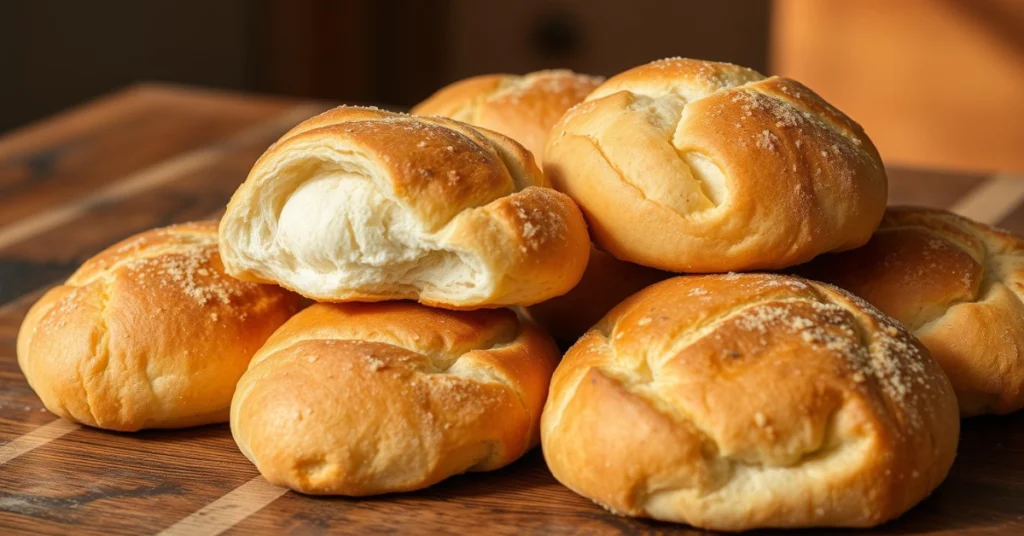
Step-by-Step Matjesbrötchen Recipe
Making the perfect Matjesbrötchen, a favorite German herring bread roll, is a fun journey. Let’s explore how to make this Northern German treat step by step.
Preparing the Components
First, get your ingredients: 2-3 fillets of Matjes herring, a crusty bread roll, a small red onion, 2-3 lettuce leaves, 2-3 slices of pickles, and 1 tablespoon of butter or cream cheese. Start by:
- Rinsing and patting the Matjes herring fillets dry with a paper towel.
- Slicing the bread roll in half horizontally to create a top and bottom.
- Thinly slicing the red onion and rinsing it under cold water to remove the sharp edge.
- Washing and tearing the lettuce leaves into bite-sized pieces.
- Slicing the pickles into thin rounds.
Assembly Instructions
Now that everything is ready, let’s put your Matjesbrötchen together. Start by spreading butter or cream cheese on the bottom half of the bread roll. Then, place the Matjes herring fillets on top. Add the sliced onion, lettuce, and pickles over the herring for a colorful and tasty mix.
Finishing Touches
To finish your Matjesbrötchen, add some fresh dill or parsley on top. A squeeze of lemon juice can also add a nice zesty touch. Serve your Matjesbrötchen right away for the best taste and texture.
Enjoy your homemade Matjesbrötchen, a true taste of Northern German culinary tradition. With its delicate herring, crisp vegetables, and soft bread, this classic sandwich is a delightful way to savor the flavors of the region.
Classic Toppings and Accompaniments for Your Matjesbrötchen Recipe
Matjesbrötchen is more than pickled herring on bun. It’s about the mix of toppings and sides that make it special. This Northern German street food combines old and new flavors for a perfect bite.
Thinly sliced red onions are a key topping. They add a sharp contrast to the creamy herring. Fresh dill pickles also add a tangy touch, balancing the savory herring.
Fresh dill sprigs can add a fragrant herbal flavor. Some people like to add lettuce or tomato for extra crunch and juiciness.
Traditional sides like German potato salad, Spicy Jalapeno fries, or Amsterdam street food French fries go well with Matjesbrötchen. They balance the herring’s richness with their starchiness.
A cold German beer or zesty lemonade can refresh your meal. They cut through the herring’s richness, making the meal satisfying.
Trying the traditional toppings and sides is essential for enjoying Matjesbrötchen. Each part, from onions to pickles and potato salad, is crucial. Whether in amsterdam street food or a German cafe, the right pairings enhance this Northern German classic.
Tips for Creating the Perfect Flavor Balance in Your Matjesbrötchen Recipe
Making the perfect matjesbroodjes (Dutch-style matjes herring sandwiches) is all about balance. You need to pay attention to how you season, mix ingredients, and avoid mistakes. With a few simple tips, you can make your matjes recipe even better.
Seasoning Guidelines
Begin with fresh, top-quality matjes herring fillets. To soften the onions, marinate them in vinegar or lemon juice first. Try different sauces like creamy remoulade or tangy dill to add more flavor to your matjesbroodjes.
Texture Combinations
- Pair the tender matjes herring with crunchy veggies like shredded lettuce or cucumbers.
- Match the soft bread with the herring’s chewiness and the crunch of pickled onions.
- Try different breads, like crusty rolls or rye, to find the best match for your matjesbroodjes.
Common Mistakes to Avoid
- Avoid adding too many toppings, as they can mask the herring’s flavor.
- Don’t use stale or dry bread, as it can ruin the sandwich.
- Choose high-quality matjes herring for the best taste.
By following these tips, you’ll get closer to making the perfect matjesbroodjes. They’ll show off the true taste of this German coastal treat.
Serving Suggestions and Pairing Recommendations for the Matjesbrötchen Recipe
The traditional Dutch fish sandwich, known as Matjesbrötchen, is loved in Northern Germany and more. It’s great for lunch, a snack, or dinner. Enjoy it in Amsterdam street food markets or at home with many serving ideas.
Matjesbrötchen pairs well with drinks. Try it with a German beer, sparkling water, or a chilled white wine. These drinks match its tangy and delicate taste.
Matjesbrötchen goes well with German classics. Try it with potato salad, coleslaw, or pickled veggies. For a bigger meal, pair it with a light soup or crispy fries.
| Beverage Pairing | Side Dish Suggestions |
|---|---|
| German Beer | Potato Salad |
| Sparkling Water with Lemon | Coleslaw |
| Riesling or Gewürztraminer | Pickled Vegetables |
| Herbal Tea | Vegetable Soup |
| Non-Alcoholic Cider | French Fries |
Matjesbrötchen can be enjoyed in many ways. Some prefer it the traditional way, while others like to get creative. It’s perfect for any occasion, offering a taste of Northern Germany’s coast.
Conclusion
Matjesbrötchen, the German fish sandwich, is a delightful treat. It's simple yet packed with flavor, holding a special place in German culture. It's a must-try for those exploring Germany's coastal food scene.
With the right matjesbrötchen recipe and some helpful tips, you can make this German street food at home. It's a chance to bring a piece of German coastal tradition into your kitchen. Enjoy the mix of tastes that makes Matjesbrötchen so loved and sought after.
Matjesbrötchen is perfect for seafood lovers or those new to German food. It takes you on a journey through its history, culture, and flavors. It's a way to experience the lively coastal communities that have loved this dish for years.
FAQ
What is Matjesbrötchen?
Matjesbrötchen is a traditional German dish loved in northern coastal areas. It's made with young pickled herring, called matjes, on a crusty bread roll. Onions and pickles add flavor.
Where does Matjesbrötchen originate from?
It comes from coastal areas centuries ago. It's a symbol of Germany's sea culture and is seen as a national treasure.
What are the key ingredients in Matjesbrötchen?
The main ingredients are matjes herring, fresh bread rolls, and thinly sliced red onions. Dill pickles, fresh herbs, butter, and dressing are optional.
How do you select high-quality matjes herring for Matjesbrötchen?
Choose herring that's tender and lightly pickled. It should not be too salty. Freshness is key for great taste and texture. The special marination makes it tangy and delicate.
What type of bread is best for Matjesbrötchen?
Use fresh, crusty bread rolls. They should be soft inside and slightly crusty outside. The bread must hold the fillings well without getting soggy.
What are common toppings and accompaniments for Matjesbrötchen?
Thinly sliced red onions, dill pickles, and fresh herbs like dill are common toppings. You can also have potato salad, french fries, or a cold German beer as accompaniments.
How can you achieve the right flavor balance in Matjesbrötchen recipe?
Use fresh ingredients and marinate onions in vinegar or lemon juice. Try different sauces like remoulade or dill sauce. Don't overload the sandwich or use stale bread.
What is Matjesbrötchen recipe?
Matjesbrötchen is a popular Northern German sandwich made with Matjes herring, a young and mild pickled herring. The herring is served in a crusty bread roll and is often garnished with toppings like onions, pickles, dill, or creamy sauces. It is a beloved snack or light meal in coastal regions of Germany.
How is Matjes Herring Made?
Matjes herring is made by curing young herring in a brine of salt, sugar, and spices. The process preserves the fish and gives it a delicate, slightly sweet flavor while maintaining its soft texture. The traditional method also ensures the herring retains its natural fats, making it a delicacy in Northern Europe.
What is the Matjesbrötchen recipe for Mohallabia?
Mohallabia is a creamy Middle Eastern dessert made with milk, sugar, and cornstarch. It is flavored with rose or orange blossom water and often garnished with nuts. The dessert is chilled before serving, making it a refreshing treat.
What is the Matjesbrötchen recipe for Sangria?
Sangria is a Spanish beverage made with red wine, brandy, orange liqueur, and fresh fruits like oranges, lemons, and berries. The mixture is chilled and served with sparkling water or soda for a light, fruity, and refreshing drink.

